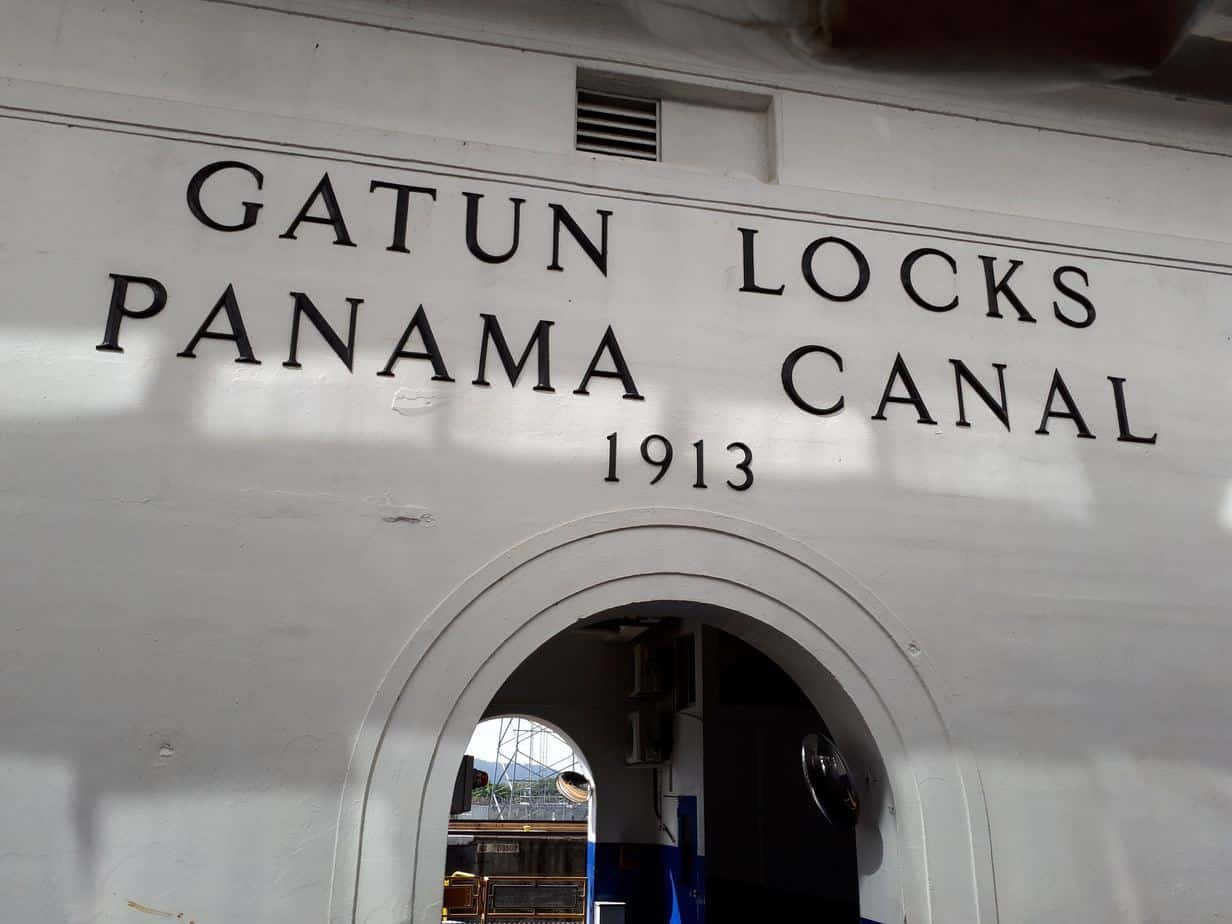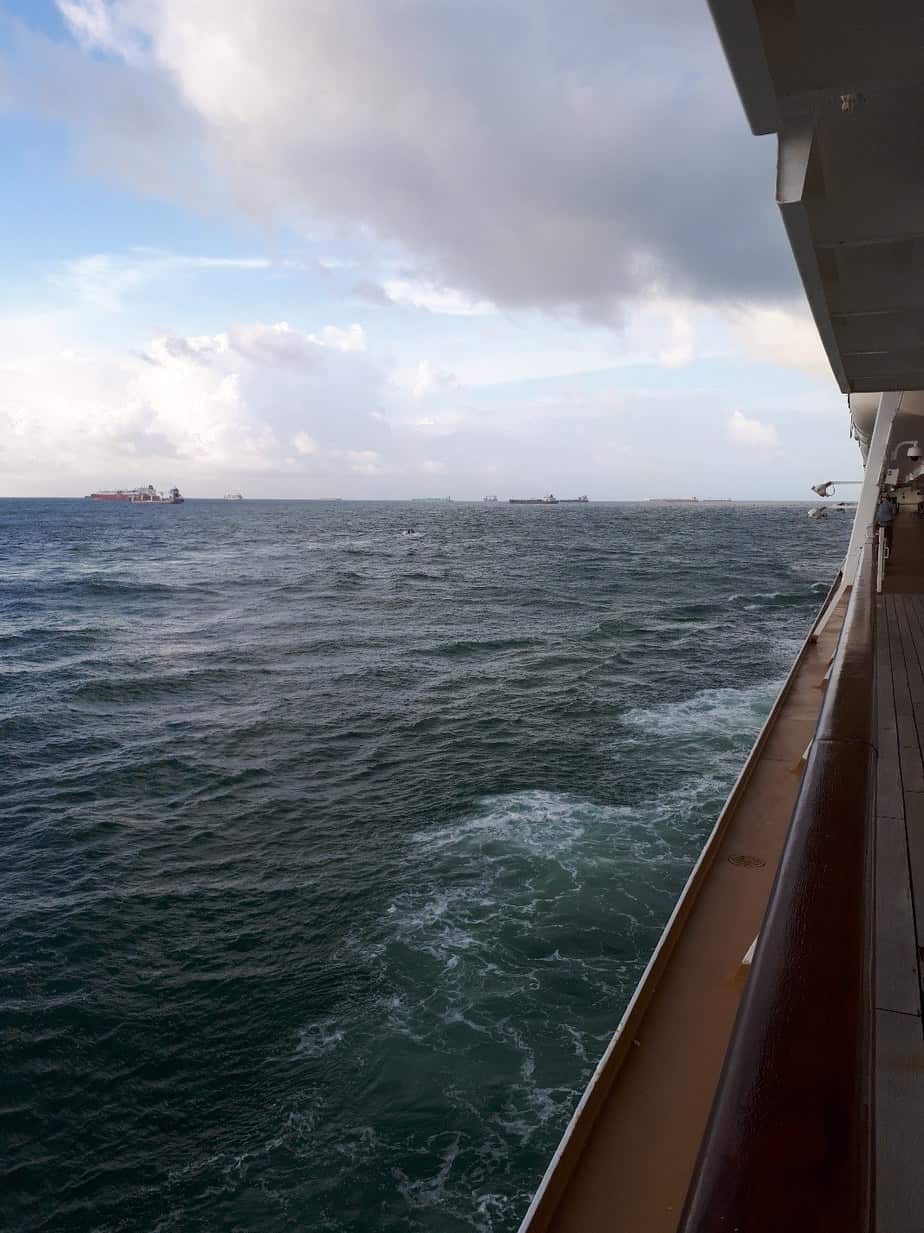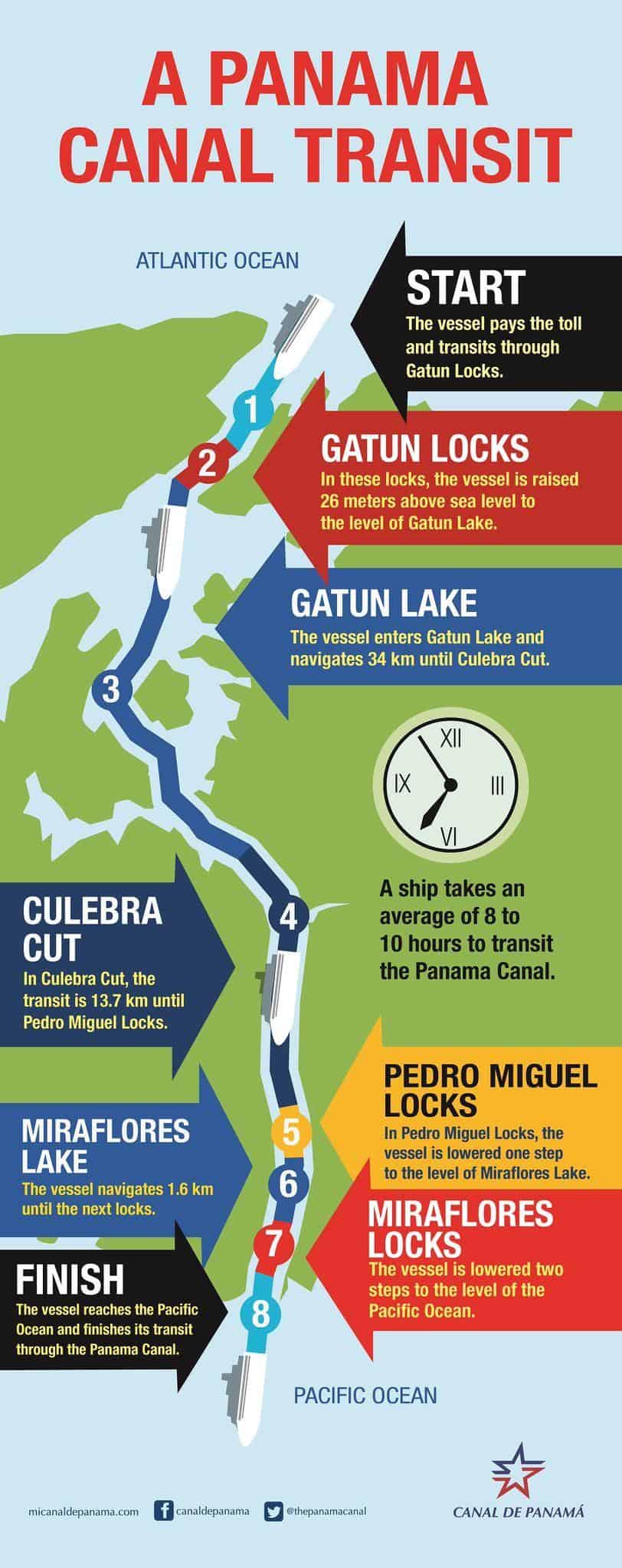If the Panama Canal is on your bucket list, a cruise might be just the ticket for you. Far more than just an engineering marvel, it's become a critical pathway interconnecting two oceans. There are so many amazing facts about Panama Canal that lots of people miss out on.
Being a bit of a research nerd, I like to educate myself on the places I will see. Finding a book in the ship’s library was like gold for me.
The problem was I had three days before we started our transit. With daily excursions booked and the incredible dining / shows in the evening; there simply wasn’t much time to read.
So, not to disturb my wife, I consumed chapter after chapter into the wee hours of the morning perched upon the ivory throne.
While it wasn’t the most comfortable reading position, I was so enthralled it was difficult to stop reading.

You might wonder why it's so special. Why it's considered one of the seven wonders of the modern world? With almost a million tourists each year, it certainly draws people’s interest. An interesting tidbit is about a third of all visitors are aboard cruise ships.
It's one of the largest and most difficult engineering projects ever undertaken, certainly at the turn of the century. For the past 100+ years, it has dramatically shortened travel time as well as shipping costs.
What to Expect on the Cruise
For me, this might be the most intriguing cruise I've ever been on. As spectacular as the cruise was, it was the people I met that made it even more memorable.
Likely, your fellow passengers are from all across the world including Canada, Australia, the UK, Germany, and more.
Probably, there won't be too many children and many of the passengers will be 50 plus.
This is the trip of a lifetime for many who finally have the time / financial resources to have this experience. My advice is to keep yourself open to meeting new people and you might make this your best adventure ever.
Fun Things to Do in Retirement describes some of the incredible people we have met while on a cruise.
It's an early morning start, especially if you stayed up too late the night before. Squeezing in those last chapters probably wasn’t the brightest thing to do.
The public announcement system comes alive and a narrator begins sharing information and explaining the history. The atmosphere aboard the ship is buzzing with excitement as we approach the Miraflores locks.

Miraflores Locks
There's another cruise ship already in the lock as we approach. There are two parallel lanes which allows us to view her being raised as we're poised to enter ours.
This is the “Big Event” and what everyone came to see. It was standing room only with the deck railings absolutely jam packed.
Peering down, you see little locomotives called “mules” maneuvering and pulling the ship forward.
There's so little clearance that the mules are critical for safely moving the ship into and through the locks. The massive gates swing and close behind us.
Nothing quite describes the sensation of floating upward on a 91,740-ton ship. The water beneath us churns and in less than ten minutes everything appears even smaller.
Between these two locks, we'll be lifted between 43 to 64.5 feet, depending upon if it's low-tide or high-tide. Each time a ship passes through, 53,400 US gallons of freshwater are discharged into the ocean.



Image from: https://en.wikipedia.org/wiki/Miraflores_(Panama)#/media/File:Miraflores_Locks,_Panama_-_10.jpg
Culebra Cut
Onward and upwards, it’s about a mile to Pedro Miguel locks which will raise the ship another 31 feet. It seems like in almost no time at all we achieve our maximum elevation of 85 feet above sea level.
Looking forward, the skyline is dominated by the Centennial Bridge. Completed in 2004, six lanes of traffic (5,007 feet long) arch across the channel. This also marks the beginning of the Culebra cut.


The Culebra cut (previously known as the Gaillard Cut) was the most difficult part of the construction. Over 60 million pounds of dynamite were used to blast through the rock. In excess of 200 million cubic yards of earth were excavated.
While only eight and a half miles long, it's also the narrowest and most dangerous part. The narrowest spot is only 300 feet wide. There's extensive terracing on the hillsides to minimize land slides during the rainy season.


Gatun Lake
When it first opened, Gatun Lake was the largest man-made lake in the world. Besides functioning as a water reservoir, the lake also supports a rich ecosystem.
Encompassing approximately 164 square miles, the fresh-water lake is replenished during the rainy season.


Credits: Williamborg/wikipedia.org
This is when you sit back and relax as it's 20.3 miles to the Gatun locks. You’ll likely see many other ships during this stage of the crossing.
Gatun Locks
As interesting as the passage was, it's been a long, hot day. Gatun locks finally come into view and there's a lot less passengers crowding the decks. For me, it’s the perfect opportunity to get to the front of the ship.
Surprisingly, they still use a rowboat to connect the cables from the mules to the ship. While it's a tried and true method, somehow, I expected something a little more elaborate.

Once we're in Gatun lock, I want to get down to a lower deck to really observe things. The sides are so close, that you can almost touch them!
Being up close is even more impressive! We're passing through three consecutive locks which will lower us down 85 feet bringing us back to sea level.


Sailing into the Caribbean, I can’t help but notice all the ships preparing for their turn. It really has been an amazing day!
The Importance of the Canal
Without this passage, ships would need to sail around South America adding approximately 7,900 miles to their journey. Also, Cape Horn is notorious for raging storms and shipping dangers.
Time is money in the shipping industry and sailing around the horn added, at least, an extra week of travel time plus much higher fuel costs. In comparison, it takes between 8-10 hours to transit the 50 miles in safety.
Traffic Volume
There's an immense amount of traffic. According to the Panama Canal Museum, 12,000 to 15,000 vessels traverse it each year.
In 2017, the volume of traffic was 13,548 vessels transporting 403.8 million tons of cargo. That works out to about 40 ships each and every day. You may notice long lines of ships queuing at each end.
Most people are unaware that it's not “first come, first served”. In fact, the transit bookings are often made more than a year in advance.
One of the facts about Panama Canal is you can rest assured that if you're not on the ship, it won't wait for you.
Cost to Transit
The operation of it is around the clock 365 days a year. It's big business and every vessel pays a toll to the authority. Our narrator announced the toll for our ship was $470,000.00!
Further investigation revealed that the tolls are based on the number of passengers with a cost of $138.00 to $148.00 per bed (berth).
In addition, cruise ships pay a premium of $35,000 to reserve a specific time to enter. This ensures the transit is completed during daylight hours. All these costs are built-in to your “port fees and taxes”.
This is why this cruise is, usually, a bit more expensive than your run-of-the-mill Caribbean cruise. Cargo vessels are charged based on their size and tonnage.
Expansion and New Locks
Back in 1914, the locks were designed to fit the vessels of the time. Thus, the locks were 1,050 feet long, 110 feet wide, and 42 feet deep.
This led to what is referred to as “Panamax” ships which are a maximum of 965 feet long, 106 feet wide, and a depth of no more than 39.5 feet.
Today, we observe much larger mega-ships going through. In 2007, the Panamanians undertook a $5.25 billion expansion project adding larger locks.
Completed in 2016, the new locks are 1,400 feet long, 180 feet wide, and 60 feet deep. The project also required the widening and deepening of existing channels.
A Tropical Climate
With the equator only 622 miles to the south, the climate is a tropical, hot and humid one. Light clothing is best and some may find it almost stifling on the deck or balcony. Rain seldom occurs outside the rainy season from May to November.
The average rainfall is 130 inches on the Caribbean side with the Pacific side receiving 68 inches. The average temperature is 81 degrees creeping up to 84 degrees during the summer months. The best time to cruise is between December and March so you can avoid the rainy season.
For the past 100 years, the watershed has replenished itself. However, in recent years, there has been rising concerns about global weather changes (El Nino).
The years 2014 to 2016 were the driest years on record. This has led the authorities to implement water conservation practices.
For example, the new locks have tubs that recover 60% of the water which is, then, recycled (less lost to the sea).
Types of Cruises / Transits
If you want to see it in its entirety, consider a full-transit cruise. Generally, these leave from Florida or California and are typically 10 to 15 days in length.
In my opinion, these cruises provide the full experience of traversing the entire waterway. In addition, most of them, also, make stops in Guatemala, Nicaragua, Costa Rica, and Mexico to name a few.
Numerous Caribbean cruises offer partial transits. This means they'll enter and exit through the Gatun locks.
Thus, you get to see the locks in action while still remaining on the Caribbean side. These cruises also offer day excursions such as an eco-tour, train rides, or seeing Colon.
Who Owns It?
Riots in 1964 raised questions as to the right of Americans to control the passageway.
With escalating tension and unfavorable world opinion, President Jimmy Carter signed the 1977 treaty to transfer authority.
Neutrality was explicitly stated with the military right of the US to defend the waterway if threatened.
The United States transferred ownership and control to Panama on December 31, 1999. It was completed peacefully. It's operated by the government-owned Panama Canal Authority.
Like many central American countries, Panama was poor and the waterway has greatly improved their prosperity.
In 2018, revenues of $2.5 billion were generated. Moreover, its operations provide approximately 9,000 jobs.
A Brief History of the Isthmus
Learning a few more facts about Panama Canal made my cruise more meaningful. For instance, the first transcontinental railway in the world was completed across the isthmus in 1855. The primary reason was the increased traffic after the California gold rush of 1849.
This was built by the US at a cost of $8 million with an estimated 5,000-10,000 lives lost. It greatly reduced the travel time for passenger, mail, and freight of the era. This underscored the need for ship passage between the oceans.
The Futile French Effort
After completing the Suez Canal in 1869, the French builder Ferdinand de Lesseps turned his eye to Panama. Amidst great fanfare, the French valiantly began digging in 1881.
By 1889, they'd spent $287 million and were bankrupt. Their colossal failure was largely due to underestimating the unique challenges of construction faced in building the crossing:
The American Success
Initially, there was strong political desire to build a passageway through Nicaragua. Besides being closer to the US, it was considered easier.
If it had not been for a series of volcanic eruptions at the time of debate, it may very well have been built in Nicaragua.
As a sea level waterway was clearly impractical, the design soon became a lock-based system. American ingenuity and efficiency called for bigger and better equipment such as steam shovels almost twice the size of the French.
Most importantly, medical breakthroughs identified the causes of malaria and yellow fever reducing mortality to 5,609.
Even with these advantages, it would take a further 10 years and $375 million (about $8 billion in today’s money) to complete.
The Culebra cut remained one of the greatest obstacles. Over 60 million pounds of dynamite were used to blast through the rock.
Landslides remained an ever-present threat. Whereas the French had removed about 30,000 cubic yards, the Americans excavated closer to 240,000 cubic yards.
Over 4.5 million yards of concrete was used in the construction of the locks and dams. The side walls at the base are 45 to 55 feet thick.
These taper to the top with a thickness of 8 feet. The center wall between chambers is 60 feet thick. The steel gates that open and close the locks are seven-feet-thick.
Closing Thoughts on the Facts About Panama Canal
After over 100 years of operation, the locks still work as well as they did in 1914. People from around the world flock to observe the waterway that changed our world; with the best way being aboard a ship.
Seeing the operation of the locks is impressive, yet it's the sheer volume of excavation that's even a greater accomplishment.
The simple truth is that it's an engineering marvel and, truly, a “monument of the millennium”.





